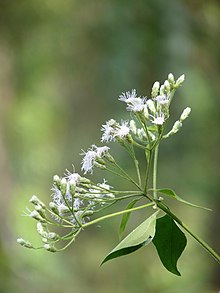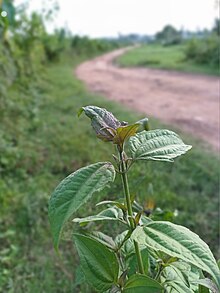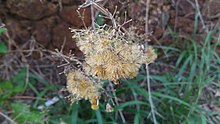| Chromolaena odorata | |
|---|---|

| |
| Conservation status | |
 Secure (NatureServe) | |
| Scientific classification | |
| Kingdom: | Plantae |
| Clade: | Tracheophytes |
| Clade: | Angiosperms |
| Clade: | Eudicots |
| Clade: | Asterids |
| Order: | Asterales |
| Family: | Asteraceae |
| Genus: | Chromolaena |
| Species: | C. odorata |
| Binomial name | |
| Chromolaena odorata (L.) R.M.King & H.Rob. | |
| Synonyms | |
Synonymy
| |



Chromolaena odorata is a tropical and subtropical species of flowering shrub in the family Asteraceae. It is native to the Americas, from Florida and Texas in the United States south through Mexico and the Caribbean to South America. It has been introduced to tropical Asia, West Africa, and parts of Australia.
Common names include Siam weed, rouge plant, Christmas bush, jack in the box, devil weed, common floss flower, hagunoy (Cebuano language), rompe saragüey (Spanish), Abani di egwu or Nsiibilibe (Igbo language), ewé Akíntọ́lá (Yorùbá) and triffid.
Description
Chromolaena odorata is a rapidly growing perennial herb. It is a multi-stemmed shrub which grows up to 2.5 m (100 inches) tall in open areas. It has soft stems but the base of the shrub is woody. In shady areas it becomes etiolated and behaves as a creeper, growing on other vegetation. It can then become up to 10 m (33 feet) tall. The plant is hairy and glandular and the leaves give off a pungent, aromatic odour when crushed. The leaves are opposite, triangular to elliptical with serrated edges. Leaves are 4–10 cm long by 1–5 cm wide (up to 4 x 2 inches). Leaf petioles are 1–4 cm long. The white to pale pink tubular flowers are in panicles of 10 to 35 flowers that form at the ends of branches. The seeds are achenes and are somewhat hairy. They are mostly spread by the wind, but can also cling to fur, clothes and machinery, enabling long-distance dispersal. Seed production is about 80,000 to 90,000 per plant. Seeds need light to germinate. The plant can regenerate from the roots. In favorable conditions the plant can grow more than 3 cm per day.
Classification
It was earlier taxonomically classified under the genus Eupatorium, but is now considered more closely related to other genera in the tribe Eupatorieae.

Invasive species

Chromolaena odorata is considered an invasive weed of field crops and natural environments in its introduced range. It has been reported to be the most problematic invasive species within protected rainforests in Africa. In Western Africa it prevents regeneration of tree species in areas of shifting cultivation. It affects species diversity in southern Africa. The plant's flammability affects forest edges.
In Sri Lanka it is a major weed in disturbed areas and coconut plantations.
Control
Biological control with a defoliating Arctiid moth was attempted in the 1970s.
A pilot study in the Ashanti region of Ghana introduced the moth Pareuchaetes pseudoinsulata to some effect.
In Australia a systematic eradication programme with herbicide has been initiated.
The gall forming tephritid fly Cecidochares connexa was introduced into Guam from Indonesia in 1998 and is widespread across the island. Chromolaena odorata forms galls around the fly larvae that become a nutrient sink that diverts energy away from plant growth to provide nutritive tissue along the walls of the larval chamber. Between 1 and 7 larvae can be found in each gall.
History of introduction
In the nineteenth century Chromolaena odorata escaped from the botanical gardens at Dacca (India), Java (Indonesia) and Peradeniya (Sri Lanka). In Western Africa the plant was accidentally introduced with forestry seeds. It was introduced as an ornamental in Southern Africa, and was introduced to Ivory Coast in 1952 to control Imperata grasses. It was first found in Queensland, Australia in 1994 and was perhaps introduced with foreign pasture seeds. Chromolaena odorata was found on the eastern portion of the Big Island of Hawai'i in 2021.
Uses
The plant is referred to as "rompe saragüey" by practitioners of Santeria, who use it for spiritual purposes. This use was famously mentioned in the salsa song "Rompe Saragüey" by Héctor Lavoe. C. odorata is commonly used in Latin America as an incense to spiritually cleanse a household, especially in Santería in Cuba and Puerto Rico.
Toxicity
Chromolaena odorata is toxic to cattle and is larvicidal against all major mosquito vectors. It can also cause allergic reactions.
See also
- John Wyndham's The Day of the Triffids— the post-apocalyptic novel from which the plant receives one of its colloquial names
References
- "NatureServe Explorer 2.0". explorer.natureserve.org. Retrieved 13 November 2022.
- "Chromolaena odorata (L.) R.M.King & H.Rob.". The Global Compositae Checklist (GCC) – via The Plant List. Note that this website has been superseded by World Flora Online
- Nesom, Guy L. (2006). "Chromolaena odorata". In Flora of North America Editorial Committee (ed.). Flora of North America North of Mexico (FNA). Vol. 21. New York and Oxford: Oxford University Press – via eFloras.org, Missouri Botanical Garden, St. Louis, MO & Harvard University Herbaria, Cambridge, MA.
- "Chromolaena odorata". County-level distribution map from the North American Plant Atlas (NAPA). Biota of North America Program (BONAP). 2014.
- "Chromolaena odorata (L.) R. M. King & H. Rob". Germplasm Resources Information Network. Agricultural Research Service, United States Department of Agriculture. Retrieved 15 July 2017.
- Chen, Yilin; Kawahara, Takayuki; Hind, D. J. Nicholas. "Chromolaena odorata". Flora of China. Vol. 20–21 – via eFloras.org, Missouri Botanical Garden, St. Louis, MO & Harvard University Herbaria, Cambridge, MA.
- "Chromolaena odorata (L.) R.M. King & H. Rob.". Tropicos. Missouri Botanical Garden.
- "Species: Chromolaena odorata (Siam Weed)". bie.ala.org.au. Atlas of Living Australia. Retrieved 4 June 2021.
- Nesom, Guy L. (2006). "Chromolaena odorata". In Flora of North America Editorial Committee (ed.). Flora of North America North of Mexico (FNA). Vol. 21. New York and Oxford: Oxford University Press. Retrieved 2011-08-25 – via eFloras.org, Missouri Botanical Garden, St. Louis, MO & Harvard University Herbaria, Cambridge, MA.
- ^ Lalith Gunasekera, Invasive Plants: A guide to the identification of the most invasive plants of Sri Lanka, Colombo 2009, p. 116–117.
- Lalith Gunasekera, Invasive Plants: A guide to the identification of the most invasive plants of Sri Lanka, Colombo 2009, p. 116–117. ”Siam weed or chromolaena (Chromolaena odorata)” Weed Management Guide at http://www.environment.gov.au/biodiversity/invasive/weeds/publications/guidelines/alert/pubs/c-odorata.pdf and Pierre Binggeli ”Chromolaena odorata (L.) King & Robinson (Asteraceae)”, 1997, at http://pages.bangor.ac.uk/~afs101/iwpt/web-sp4.htm
- GJ Schmidt; EE Schilling (May 2000). "Phylogeny and Biogeography of Eupatorium (Asteraceae: Eupatorieae) Based on Nuclear ITS Sequence". American Journal of Botany. 87 (5). Botanical Society of America: 716–726. doi:10.2307/2656858. JSTOR 2656858. PMID 10811796.
- "Siam weed or chromolaena (Chromolaena odorata)" Weed Management Guide at http://www.environment.gov.au/biodiversity/invasive/weeds/publications/guidelines/alert/pubs/c-odorata.pdf and Pierre Binggeli ”Chromolaena odorata (L.) King & Robinson (Asteraceae)”, 1997, at http://pages.bangor.ac.uk/~afs101/iwpt/web-sp4.htm
- TT Struhsaker; PJ Struhsaker; KS Siex (May 2005). "Conserving Africa's rain forests: problems in protected areas and possible solutions". Biological Conservation. 123 (1): 45–54. Bibcode:2005BCons.123...45S. doi:10.1016/j.biocon.2004.10.007. ISSN 0006-3207. Archived from the original (PDF) on 2021-01-07. Retrieved 2009-11-19.
- Pierre Binggeli ”Chromolaena odorata (L.) King & Robinson (Asteraceae)”, 1997, at http://pages.bangor.ac.uk/~afs101/iwpt/web-sp4.htm
- Gunasekera, L. (2009). Invasive Plants: A guide to the identification of the most invasive plants in Sri Lanka. Colombo. 116-117
- "Effect of Biological Control of Chromolaena odorata on Biodiversity: a Case Study in the Ashanti Region of Ghana". Archived from the original on 2011-04-09. Retrieved 2021-07-13.
- Pierre Binggeli ”Chromolaena odorata (L.) King & Robinson (Asteraceae)”, 1997, at http://pages.bangor.ac.uk/~afs101/iwpt/web-sp4.htm ”Siam weed or chromolaena (Chromolaena odorata)” Weed Management Guide at http://www.environment.gov.au/biodiversity/invasive/weeds/publications/guidelines/alert/pubs/c-odorata.pdf
- Cruz, Z.T., Muniappan, R., Reddy, G.V.P. (2007). Establishment of Cecidochares connexa (Diptera: Tephritidae) in Guam and Its Effect on the Growth of Chromolaena odorata (Asteraceae). Annals of the Entomological Society of America. 845-850.
- Pierre Binggeli ”Chromolaena odorata (L.) King & Robinson (Asteraceae)”, 1997, at http://pages.bangor.ac.uk/~afs101/iwpt/web-sp4.htm
- "Invasive and toxic 'devil weed' found on Big Island". 28 September 2021.
- Gade, S; Rajamanikyam, M; Vadlapudi, V; et al. (2017). "Acetylcholinesterase inhibitory activity of stigmasterol & hexacosanol is responsible for larvicidal and repellent properties of Chromolaena odorata". Biochimica et Biophysica Acta (BBA) - General Subjects. 1861 (3): 541–550. doi:10.1016/j.bbagen.2016.11.044. PMID 27916676.
- ”Siam weed or chromolaena (Chromolaena odorata)” Weed Management Guide at http://www.environment.gov.au/biodiversity/invasive/weeds/publications/guidelines/alert/pubs/c-odorata.pdf
Further reading
- Pink, A. (2004). Gardening for the Million. Project Gutenberg Literary Archive Foundation.
- Raimundo, R. L. G., R. L. Fonseca, R. Schachetti-Pereira, A. T. Peterson & Thomas Michael Lewinsohn, 2007.Native and Exotic Distributions of Siamweed (Chromolaena odorata) Modeled Using the Genetic Algorithm for Rule-Set Production. Weed Science, 55 (1): 41–48 | Abstract
- ”Siam weed or chromolaena (Chromolaena odorata)”, Weed Management Guide, ISBN 1-920932-36-4. At http://www.environment.gov.au/biodiversity/invasive/weeds/publications/guidelines/alert/pubs/c-odorata.pdf
- Pierre Binggeli ”Chromolaena odorata (L.) King & Robinson (Asteraceae)”, 1997, at http://pages.bangor.ac.uk/~afs101/iwpt/web-sp4.htm
- Lalith Gunasekera, Invasive Plants: A guide to the identification of the most invasive plants of Sri Lanka, Colombo 2009, p. 116–117.
External links
 Media related to Chromolaena odorata at Wikimedia Commons
Media related to Chromolaena odorata at Wikimedia Commons Data related to Chromolaena odorata at Wikispecies
Data related to Chromolaena odorata at Wikispecies- Queensland Government Factsheet
- Dressler, S.; Schmidt, M. & Zizka, G. (2014). "Chromolaena odorata". African plants – a Photo Guide. Frankfurt/Main: Forschungsinstitut Senckenberg.
| Taxon identifiers | |
|---|---|
| Chromolaena odorata |
|
| Eupatorium odoratum | |